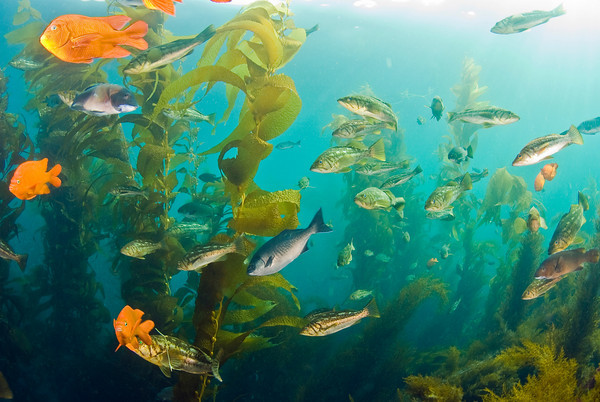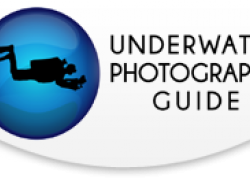Catalina Island Diving & Underwater Photography Guide
Catalina Island is a popular location for underwater photography and diving in the Southern Channel Islands, in Southern California. Beautiful giant kelp forests surround the island, and large black sea bass frequent the waters. California marine life is very prolific here. There is also the popular Catalina Dive Park. Scuba diving Catalina Island is a wonderful experience you will never forget.

Giant kelp forest photo at Catalina Island. Most dive sites at Catalina have large kelp forests. Read more about navigating kelp safely.
Catalina Island Marine life and Underwater photography subjects
Giant Kelp forests are everywhere around the island rising up from 25ft-65ft on the bottom up to the surface. Current can often be gauged by looked down at the kelp from a boat. Large Bat rays are often sitting in the sand near the kelp. Giant sea bass are most often seen east of Two Harbors on the frontside of the island, at 40-70ft deep. Angel sharks are found in the sand, near where the kelp/reef ends - often at 90-100ft deep
Mantis shrimp - live in large holes in the sand, 50-80ft deep. Near Little Gibraltar is a good place. Octopus can be found in many crevices at 20-40ft deep. Moray Eels are in cracks and crevices 30-45ft deep, especially on the frontside. Horn sharks & Leopard sharks are often seen. Sea fans & Anemones adorn many dive sites, and Farnsworth Banks has purple hydrocoral.
Harbor Seals can be found in shallow water in the kelp, and Garibaldi & Sheephead are found everywhere, as arae Blue-banded Gobies. Zebra gobies are harder to find and a rare treat. Spanish shawl Nudibranchs are found on most rocky reefs, and other nudibranchs are more seasonal
You can read more about Catalina underwater macro photography

Schools of fish at the Casino Point dive park, Catalina island. Garibaldi, sheephead and kelp bass.
Catalina's Best dive sites for underwater photography
Farnsworth Banks - This seamount comes up to 55ft at the surface, and it lies on the backside of catalina. Beautiful purple hydrocoral lies all over this dive site, lots of fish, and torpedo rays frequent the area. Advanced divers only.
Ship Rock - Ship Rock rises from 120-200ft in the sand to above the surface. Schools of fish fill it's kelp forests, angel sharks are found in the sand, and nudibranchs lie on the deeper rocks in the spring. Nearby Bird Rock is also a nice large site with plenty of kelp and small walls.
Two Harbors area - besides Ship Rock, dive sites near Two Harbors, like Sea Fan Grotto, Blue Cavern, Lion's Head, Bird Rock and Eagle Reef all have giant kelp forests and are good for wide-angle underwater and fish photography. Go slowly in the 30-50ft range and look into cracks and crevices.
West end cove - Clear blue water is often found here, filled with schooling jack mackeral and a few shy harbor seals. There's good diving here from 100ft deep to the surface. I've seen yellowtail and mola-mola here, and there's good macro at all depths. Beware of currents.
Italian gardens - The areas around Italian gardens on the east side of catalina get frequented by Giant black sea bass from July to October, mostly around 40-70ft deep where the kelp meets the sand. Best for wide-angle shots.
Rock quarry - Scythe butterfly fish flutter in and out of rocks. Angel sharks lie in the sand deep, and the kelp forests to the east are very lush and healthy at 20-30ft deep.
Long point - A wall with sea fans drops from 60ft down to 110ft deep. The kelp forest to the west is large, tall and filled with schooling fish and nice structure, and the water here is usually quite clear.
Eagle Rock - on the west end of Catalina, right around the corner on the back side. Spectacular sea fans around the entire rock at 40-80ft depth make this one of the best wide-angle dive sites in the area.
Blue Cavern Point - beautiful wall dive with some sea fans, just east of Two Harbors, with many caves and caverns in shallow water. Excellent visibility, must be done as a drift dive. Drops down past 130ft deep.
View the dives site on this great Catalina dive site map by Phil Colla.

Purple hydrocoral at Farnsworth Banks, backside of Catalina

Sea fan at Arrow point, Catalina Island. F9, 1/125th, ISO 400

Diver at Ship Rock, Catalina Island. F9, 1/60th, ISO 200, Nikon 12-24mm at 12mm. Photo by Randy Harwood
How to Dive Catalina Island
Catalina can be dove off a dive boat, or from the shore in the towns of Avalon or Two Harbors. The shore diving area in Avalon is called Casino point dive park, and is very popular with divers.
Boat diving Catalina
You have two choices - stay in Los Angeles or Orange county and take a dive boat out of San Pedro or Long Beach, or stay on Catalina Island in Avalon or Two Harbors, and take a local dive boat there. Most trips offer 3 dives and supply food and air fills. You are responsible for your tank, weights, and rental gear, although some boats can give you a tank and/or weights. Boats from San Pedro or Long Beach usually take 12-25 divers, and reach the island in anywhere from 1.5 to 2.5 hours each way.
Diving out of Two Harbors, Catalina
If you stay in the small town of Two Harbors, you can go out on the local dive boat, or you can rent your own small boat and go out on your own. There is also excellent diving from shore at the nearby Two Harbors campground, a short walk from town.
Casino point dive park
The Casino point dive park, in Avalon on Catalina Island, is a special place. Also known as the Catalina Dive Park, divers shore dive here, getting air fills nearby. Two deep wrecks called the SueJac and the Valiant are excellent underwater photography subjects. Octopus, giant kelpfish, moray eels, garibaldi, bat rays and schooling fish all frequent the dive park. Here is a map of the dive park.
To get to the dive park, take a ferry from Long Beach or San Pedro, and then take a taxi to Casino point.
To dive the Valiant wreck, get permission from the harbor master. The wreck is 100ft in the sand, just outside of the dive park.
My favorite places in the Catalina island Dive park for underwater photography
Black sea bass are often found where the kelp meets the sand, especially in the summer.
Stay at 40ft and swim to the right (when facing the ocean) for stunning kelp, sea fans, morays, octopus, garibaldi, giant kelpfish and sheephead. I usually find the most giant kelpfish at 10-15ft depth.
The Valiant wreck, at 70-100ft depth just outside of the park, is a decent size shipwreck great for macro and wide-angle underwater photography. Look for nudibranchs on the bow (the deeper end).
The swim platform at 55ft depth, in the far left corner of the park, has many macro subjects on it such as light-bulb tunicates.
Diving early morning just near the swim steps is a serene place for wide-angle underwater photography with all of the friendly fish.

Close-up of giant kelp

Angel shark at Catalina island. F13, 1/160th

Moray eel and red sea urchin, F14, Nikon 105mm macro lens with Canon 250D diopter
Underwater photography tips
Use as wide of a lens as possible for scenic kelp forest shots and sea fan shots
Visit shallow areas (10ft) for scenic eelgrass and red algae.
Go deep or look in the spring for colorful nudibranchs.
Use a long lens for photographing Catalina's juvenile fish
Plan and prepare for your underwater photography dive
Harbor seals are mostly found shallow (20ft deep) in the kelp forests
Sea lions are best found on Santa Barbara or Anacapa islands
Take a dive boat out of San Pedro or Long beach for a 1 or 2 day trip to the island.
I prefer shooting wide-angle or juvenile fish at Catalina Island. For macro photography, I prefer the northern channel islands.

Garibaldi and red algae, shallow at the Casino point dive park. F8, 1/100th, tokina 10-17mm
Photographing baitballs at Catalina Island
When photographing baitballs underwater, I like to use a wide angle lens like my tokina 10-17mm fisheye. An INON UFL-165 wet lens also works well. Baitballs love areas of shallow water with kelp, such as this area of bird rock in 15-20ft of water. Anchovies and sardines tend to stay near the surface, so that is where you must be. The baitball passed through this point several times. Getting the sun in the photo can be quite dramatic and add contrast.

F9, 1/400th
When to dive Catalina Island
The best time to dive Catalina
Catalina is very diveable all year round. September is my favorite month.
Catalina Island Underwater Visibility
Visibility is normally 40ft. The best underwater visibility at Catalina Island is from July to December, with visibility peaking from September to November, 50-60ft visibility. Black sea bass and large baitballs visit in the summer and fall. April - June can have occasional plankton blooms that lower vis to 20ft.
Catalina Island Water Temps
The warmest temperatures are from mid-July to late September, almost 70 degrees near the surface, and the coldest waters are from March to early June, 56-59 degrees. The dive boats can be crowded in July and August. Jan to March can be clear and cold, and April - June can have occasional plankton blooms. Jan to June there are thermoclines as you get deeper (60-80ft), below the thermocline the water will be cold (low 50's) and clear (70-100ft visibility).

Garibaldi are the state fish of California, and are one of the most popular underwater photography subjects at Catalina. They are very common, especially at 20-40ft depth. Juvenile Garibaldi start off with bright blue spots, that gradually fade as they become adults. This young Garibaldi is almost an adult, and is about to lose its spots.
Catalina Island Dive Reports
Catalina Island dive report January 2010
Further reading
Marine Life Articles
Underwater photos from Catalina Island

Schooling salema at Catalina Island. F8, 1/320th, Tokina 10-17mm at 10mm

Spanish shawl nudibranch, catalina island, F25, 1/250th, 105mm macro lens

RECOMMENDED ARTICLES
SUPPORT THE UNDERWATER PHOTOGRAPHY GUIDE:
The Best Service & Prices on u/w Photo Gear
 Visit Bluewater Photo & Video for all your underwater photography and video gear. Click, or call the team at (310) 633-5052 for expert advice!
Visit Bluewater Photo & Video for all your underwater photography and video gear. Click, or call the team at (310) 633-5052 for expert advice!
The Best Pricing, Service & Expert Advice to Book your Dive Trips
 Bluewater Travel is your full-service scuba travel agency. Let our expert advisers plan and book your next dive vacation. Run by divers, for divers.
Bluewater Travel is your full-service scuba travel agency. Let our expert advisers plan and book your next dive vacation. Run by divers, for divers.

































